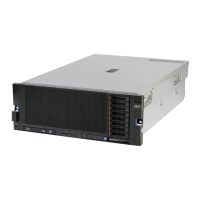3. Remove the top cover (see “Removing and replacing consumable parts and
Tier 1 CRUs” on page 105).
4. Remove the top-cover bracket (see “Removing the top-cover bracket” on page
107).
5. Remove the power supplies (see “Removing a hot-swap power supply” on
page 123).
6. Remove the I/O-board shuttle from the microprocessor-board assembly (see
“Removing the I/O-board shuttle” on page 143).
7. Remove the memory cards and memory-card fillers (see “Removing the
I/O-board shuttle” on page 143).
8. Disconnect the signal cables from the ServeRAID adapter and remove the
adapter from the server (see “Removing the RAID adapter carrier and the
RAID adapter assembly” on page 146).
9. Remove the middle fan (see “Removing the middle hot-swap fan” on page
122).
10. Remove the memory-card cage (see “Removing the memory-card cage” on
page 175).
11. Disconnect the following cables: front fan, scalability LED, operator
information panel, hard disk drive backplane, and CD/DVD power.
12. If you have a single-node server without a memory expansion module
attached, remove the QPI wrap cards or fillers (see “Removing a QPI wrap
card” on page 127). If you have a two-node server or a server that is
connected to a memory expansion module, disconnect the QPI cables from
each end and set them aside in a safe place. Be sure to protect the ends of the
QPI cables.
13. (Trained service technician only) Remove the microprocessors (see “Removing
a microprocessor and heat sink” on page 161).
14. Loosen the thumbscrews on the rear of the server. If you have a two-node
server, you might have four thumbscrews on the rear of the server. One
thumbscrew is used to connect the two-node bracket.
15. Slide the assembly slightly toward the front of the server; then, using the
microprocessor-board handle on the left side, lift the assembly out at an angle.
16. Remove the microprocessor socket covers from the new microprocessor-board
assembly and set them aside.
17. Remove microprocessors from the sockets of the old microprocessor board and
install them into the sockets on the new board using the microprocessor
installation tool.
Note:
a. If you are removing E7 series microprocessors, you must use the
microprocessor installation tool with the text “X7500 + E7” on the bottom
of the tool (see the following illustration). Tools that do not have this text
on the bottom will not work correctly with the E7 series microprocessors.
b. Be sure to keep the heat sink and microprocessor from each
microprocessor socket of the old microprocessor board together so that you
can install them on the new microprocessor board together. For example,
when you remove the heat sink and microprocessor from microprocessor
socket 1 of the old microprocessor board , install them both on the same
socket on the new microprocessor board.
c. Use an alcohol wipe to remove any thermal grease from the tabs on the
microprocessor load plate on the old microprocessor board.
172 IBM System x3850 X5 and x3950 X5 Types 7145, 7146, 7143, and 7191: Problem Determination and Service Guide

